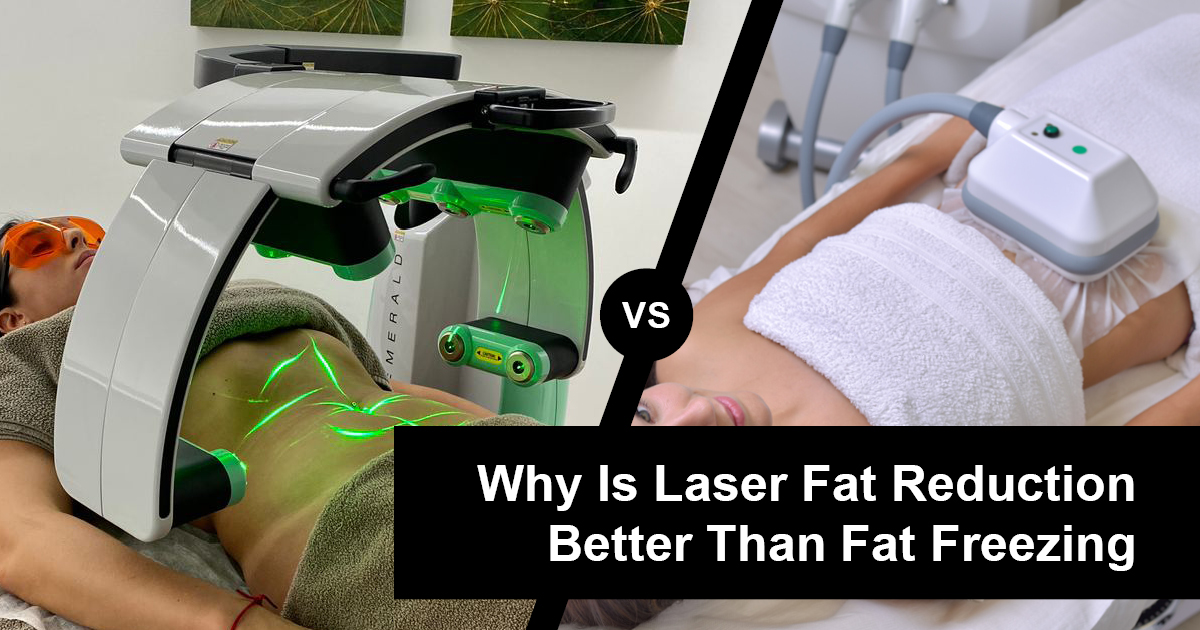
One in two people worldwide are currently trying to lose weight, including 47% of Australians1. Of those on a weight loss mission, almost half are aged between 25 and 44 years, meaning they’re more likely to welcome new advancements in weight loss technology and turn to options outside of the usual diet and exercise recommendations to see the results they want faster, and with greater ease. As such, Australia has seen a monumental rise in the number of bariatric surgeries performed annually, rising in popularity by 447% from the 2005/06 to the 2018/19 period2 – shedding some insight into the vast number of people opting for non-invasive, lower-cost and easily accessible alternative weight loss methods.
One such alternative method is fat freezing or cryolipolysis. It’s a cosmetic treatment that has soared in popularity over the past decade, being the #1 used body sculpting procedure in the United States in 2018, and gained plenty of media attention, both positively in both beauty magazines and lifestyle blogs, as well as negatively due to its risk of adverse effects, even to the point of permanent disfigurement. Today in 2023, several new treatments have entered the fat loss market that overcome almost all of the challenges and discomfort created by fat freezing, the ‘healthiest’ one of which is the Emerald Laser.
As a clinician offering cosmetic procedures, this leaves a very important question: should you invest, or continue to invest in fat freezing treatments, or is it time to explore other options like the Emerald laser? In making this choice it’s important to consider both your patients and their results, comfort and side effects, all of which impact your reputation and referral system, as well as the practical implications for your clinic and practitioners in terms of time and cost of learning new technology, treatment times, and more. Here’s a comparison of several factors for fat freezing systems such as CoolSculpting versus the Emerald laser to help you decide what’s best for your clinic in the long-term.
Mechanism Of Action
To best understand the key differences between fat freezing and laser fat reduction, let’s run through their processes. Fat freezing uses controlled cooling to freeze and destroy fat cells in targeted areas of the body. It uses a specially designed machine to vacuum the skin above the area of fatty tissue into an applicator that then rapidly cools fat cells to a temperature of between -11°C to -7°C. As fat cells are particularly vulnerable to these cooler temperatures, they can undergo a process called apoptosis, whereby the cells can break down and die. This can permanently remove the targeted fat cells, though it doesn’t prevent new fat deposits from accumulating around the body.
Emerald laser instead uses light energy that is applied to the body from a short distance, never coming in contact with the skin. The dual light wavelengths are non-thermal meaning they produce no heat (nor extreme cold), getting to work on a cellular level to produce a photochemical cascade to emulsify fat and transport it away. Specifically, the effects of the laser create small transitory pores in the fat cells for the fatty liquids to seep out, where the body then naturally processes the fatty liquids through the lymphatic system, causing the fat cells to shrink, instead of being killed off, stimulating the remaining cells to function like healthy lean fat cells, which can create a chain reaction through the messages sent to the brain and around the body to encourage other fat cells to release some of their own fatty content.
Patient Comfort
Fat freezing is marketed as having minimal discomfort and being ‘generally well tolerated’. Discomfort is noted when the applicator sucks an area of skin into the device, with the resulting tugging feeling being nicknamed a ‘shark bite’ among many of those who have experienced it. For those who experience discomfort, this is often temporary and may include numbness, mild bruising, swelling or redness, all of which should typically subside within a few days of treatment.
Emerald laser claims to have no discomfort, which makes sense given it never touches the skin, and the laser light wavelengths do not produce notable heating or cooling sensations. This is reported to leave some patients wondering if it’s really working during the procedure, though any immediate concerns are settled once the results start becoming visible and measurable.
Adverse Effects
Fat freezing carries the risk of patients experiencing adverse effects, with several studies examining these in detail.3 The most common adverse effects include redness or bruising at the treatment site, numbness or tingling and swelling. More serious complications include severe and persistent pain, nerve damage that causes the area to become itchy, burning or painful, skin hyperpigmentation, motor neuropathy meaning damage to the nerves that control our muscles leading to muscle weakness, and a condition called paradoxical adipose hyperplasia, which while originally claimed to be a ‘rare’ side effect, has come into light in recent years for being more common than originally reported, affecting 1 in every 4,000 procedures.4 In this side effect, instead of the fat cells shrinking and dying, they become bigger and firmer, being left with a “stick of butter” appearance.
Emerald laser has no adverse effects or risk of complications due to its mechanism of action. Instead, studies have shown that the effects of the laser continue in the weeks after treatment as fat from the cells continue to be metabolised due to the laser working through a primary biomechanical reaction.
Downtime
Both fat freezing and laser fat reduction do not require any downtime, other than what a person may feel they need if they experience adverse effects following fat freezing. Both treatments are marketed for the patient to be able to return to work on the same day as their treatment.
Results
For the specific areas targeted by fat freezing, studies show a reduction in the amount of subcutaneous fat by up to 20-25% for those that respond to the treatment, which has been reported as up to 86% of those treated, leaving a 73% patient satisfaction rate.5,6 Results were most noticed two months following the treatment, though it may take up to 4-6 months for the fat cells to leave a person’s body. There have been very limited studies on the longevity of fat freezing, leaving a grey area, but one study did follow two patients for 5 years following their treatment to show the treated areas remained smaller than other areas of the body.7
Studies on the Emerald laser have shown that patients typically experienced just over a 10cm circumference reduction within a month, or 1-2 dress sizes. In a double-blind placebo-controlled trial, 53 adults lost on average 10.52 cm off their hips, waist, and upper abdomen combined. The placebo group that they were tested against lost just 1.8cm. The effects continued in the weeks after treatment as the fat continued to be metabolised, with an average circumference reduction of 15.21cm when they were next examined.
Treatment Time & Target Areas
One session of fat freezing lasts for between 35 minutes and an hour and targets one treatment site. The exact treatment length typically depends on the size of your treatment site. Multiple areas can be targeted in one appointment, but this will extend the treatment time and patient cost.
An Emerald laser session lasts for a total of 30 minutes, consisting of 15 minutes of lying on your front and 15 minutes of lying on your back. During this time, the laser is applied to several areas at once due to its use of 10 laser beams simultaneously, meaning your waist, hips and abdomen can be targeted together as you lie on your back, instead of having to expend the time and patient cost to target them separately. The Emerald laser can also be set up to target additional problem areas such as the arms, neck, calves, ankles, chest and more.
Practitioner Ease Of Use
Fat freezing requires the treating practitioner to manually apply (and reapplied as needed depending on the size of the area) the device over the course of the entire treatment, ensuring the device stays correctly positioned through its suctioning, and that patients stay as comfortable as possible, and any concerns are eased during this time. Following the treatment, the area must be massaged manually.
Emerald laser requires the practitioner to correctly position the patient within the device and position the laser, and then activate the device. The practitioner is then able to answer any questions while the patient stays comfortable, without continuing to hold or reposition a device, aside from potentially asking the patient to switch from their bank to their front halfway through the treatment, depending on the areas targeted.
Added Benefits
Fat freezing is true to its one intended purpose – to freeze fat cells, holding no additional benefits. Due to the action of laser fat reduction, however, patients will also experience some collagen remodelling, simultaneously achieving modest skin tightening alongside their fat reduction. Additionally, Emerald is the only laser in the world that has been given FDA clearance for overall body circumference reduction in patients with small pockets of fat and patients with a BMI of up to 40, whereas a BMI score of below 30 is required for most body areas undergoing fat freezing (aside from a double chin), making it unsuitable for many people.
The Verdict On Fat Reduction Technology
While deciding on the best technology for fat reduction is an important business decision for a clinic and must be based on several factors including results, patient comfort, finances, time and practitioner optimisation among many others, it is clear that Emerald laser does have notable benefits over traditional fat freezing that make it more favourable and better received in today’s market, compared to years prior where there was nothing that could overcome the discomforts and challenges of fat freezing. It is also clear that the absence of side effects and complications make Emerald laser better positioned for helping clinics achieve a better reputation and supporting their referral networks to improve overall profitability from offering a fat reduction service.
You can review the scientific evidence behind the Emerald laser here, and request more information about the laser, including trialling it in your clinic, by filling in this contact form.
1 https://business.yougov.com/content/44057-52-worlds-adults-trying-lose-weight
2 https://link.springer.com/article/10.1007/s11695-022-06188-5
3 https://pubmed.ncbi.nlm.nih.gov/32976167/
4 https://www.eurekalert.org/news-releases/807341
5 https://www.ncbi.nlm.nih.gov/pmc/articles/PMC4079633/
6 https://www.plasticsurgery.org/cosmetic-procedures/nonsurgical-fat-reduction/cryolipolysis
7 https://onlinelibrary.wiley.com/doi/full/10.1111/jocd.12238


